Related Research Articles

Hermit crabs are anomuran decapod crustaceans of the superfamily Paguroidea that have adapted to occupy empty scavenged mollusc shells to protect their fragile exoskeletons. There are over 800 species of hermit crab, most of which possess an asymmetric abdomen concealed by a snug-fitting shell. Hermit crabs' soft (non-calcified) abdominal exoskeleton means they must occupy shelter produced by other organisms or risk being defenseless.

The Coenobitidae are the family of terrestrial hermit crabs, widely known for their land-living habits as adults. They are found in coastal tropical regions around the world and require access to the ocean to breed.

Clibanarius is a genus of hermit crabs in the family Diogenidae. Like other hermit crabs, their abdomen is soft-shelled and sheltered in a gastropod shell. Typically marine like all their relatives, the genus includes C. fonticola, the only known hermit crab species that spends all its life in freshwater. The feeding rates of Clibanarius species change with temperature which, given their broad distributions, may have considerable consequences for the stability reef systems as sea temperatures rise in the future.

The Diogenidae are a family of hermit crabs, sometimes known as "left-handed hermit crabs" because in contrast to most other hermit crabs, its left chela (claw) is enlarged instead of the right. It comprises 429 extant species, and a further 46 extinct species, making it the second-largest family of marine hermit crabs, after the Paguridae.

Coenobita cavipes is a species of land hermit crab native to the eastern parts of Africa, the Indonesia, Philippines, China, Japan, Malaysia, Taiwan, Polynesia, and Micronesia. While these hermit crabs are terrestrial, they prefer to reside near the shores for access of both water and land.
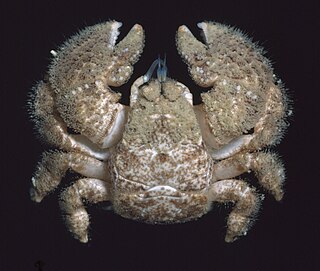
The hairy stone crab is a crab-like anomuran crustacean that lives in the littoral zone of southern Australia from Bunbury, Western Australia, to the Bass Strait. It is the only species in the family Lomisidae. It is 1.5–2.5 cm (0.6–1.0 in) wide, slow-moving, and covered in brown hair which camouflages it against the rocks upon which it lives.
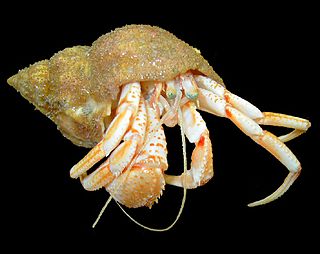
The Paguridae are a family of hermit crabs of the order Decapoda. The king crabs, Lithodidae, are now widely understood to be derived from deep within the Paguridae, with some authors placing their ancestors within the genus Pagurus.
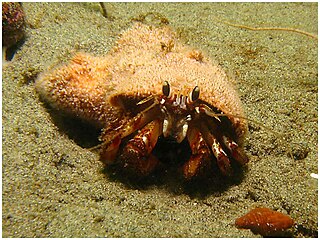
Pagurus is a genus of hermit crabs in the family Paguridae. Like other hermit crabs, their abdomen is not calcified and they use snail shells as protection. These marine decapod crustaceans are omnivorous, but mostly prey on small animals and scavenge carrion. Trigonocheirus and Pagurixus used to be considered subgenera of Pagurus, but the former is nowadays included in Orthopagurus, while the latter has been separated as a distinct genus.
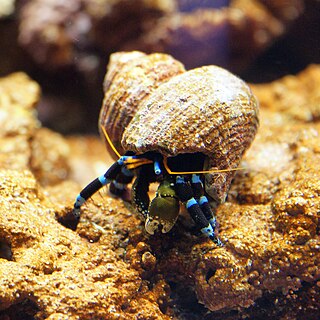
Calcinus is a genus of hermit crabs in the family Diogenidae, containing the following species:

Paguristes is a genus of hermit crab in the family Diogenidae. It includes the following species :
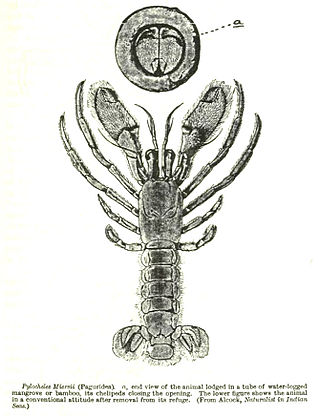
The Pylochelidae are a family of hermit crabs. Its members are commonly called the 'symmetrical hermit crabs'. They live in all the world's oceans, except the Arctic and the Antarctic, at depths of 2,000 m (6,600 ft). Due to their cryptic nature and relative scarcity, only around 60 specimens had been collected before 1987, when a monograph was published detailing a further 400.

Diogenes is a genus of hermit crabs.

Dardanus pedunculatus, commonly referred to as the anemone hermit crab, is a species of hermit crab from the Indo-Pacific region. It lives at depths of up to 27 m and collects sea anemones to place on its shell for defence.

Dardanus megistos, the white-spotted hermit crab or spotted hermit crab, is a species of hermit crab belonging to the family Diogenidae.

Ciliopagurus is a genus of hermit crabs, of the family Diogenidae, which are sometimes referred to as the "left-handed hermit crabs", because in contrast to most other hermit crabs, the left chela (claw) is enlarged instead of the right. They are found in the Indo-Pacific region and in the eastern Atlantic Ocean.
Ciliopagurus liui is a species of hermit crab native to the Gulf of Tonkin and waters to the south of Japan.
Calcinus tubularis is a species of hermit crab. It is found in the Mediterranean Sea and around islands in the Atlantic Ocean, where it lives below the intertidal zone. Its carapace, eyestalks and claws are marked with numerous red spots. C. tubularis and its sister species, C. verrilli, are the only hermit crabs known to show sexual dimorphism in shell choice, with males using normal marine gastropod shells, while females use shells of gastropods in the family Vermetidae, which are attached to rocks or other hard substrates.

Aniculus maximus, the hairy yellow hermit crab or large hairy hermit crab, is an aquatic hermit crab of the family Diogenidae.
Pylopaguropsis is a genus of hermit crabs containing the following species:

Aniculus is a genus of aquatic hermit crab of the family Diogenidae.
References
- 1 2 Henderson, J. R. (1888). Report on the Anomura Collected by H. M. S. Challenger During the Years 1873–76. London: Eyre & Spottiswoode.
- 1 2 3 Lemaitre, R., Rahayu, D. & Komai, T. (2018). A revision of “blanket-hermit crabs” of the genus Paguropsis Henderson, 1888, with the description of a new genus and five new species (Crustacea, Anomura, Diogenidae). Zookeys, 752, 17–97.